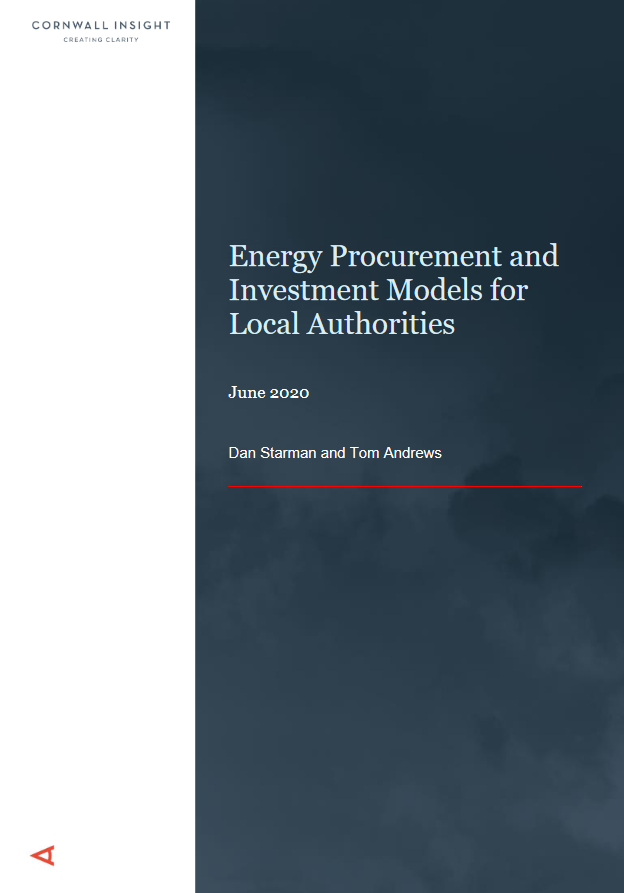A summary overview of the options available to Local Authorities (LAs) in buying or producing their own power needs.

The Local Energy Hub initiative was launched by BEIS in 2018, following its successful Local Energy Programme which offered all LEPs funding to develop regional energy strategies. The five Local Energy Hubs were financed with a £4.8mn grant to set up, in their region, a coordinator backed by teams with technical, legal and financial expertise in the energy sector. They are tasked with providing practical support to LEPs and LAs to support the development of priority energy projects, up to the point of financeability.
The Greater South East Energy Hub (GSEEH) has approached Cornwall Insight (CI) to compile a summary overview of the options available to Local Authorities (LAs) in buying or producing their own power needs.
This is not a comprehensive summary and nor does it make recommendations for an LA, but provides a condensed summary of six high level options available to LAs, summarising:
- The approach and process taken
- The relative strengths, weaknesses, opportunities and threats of each option (a SWOT analysis)
- The key risks associated with each option at the time of writing
- Other points relevant to the decision-making process and some examples of each option
The paper covers
- Open market and collective purchase
- Corporate PPAs
- LA Ownership of Assets
- JV Asset Development
- Purchasing Developed Assets
- Land Leasing Options
There is also a glossary at the rear to explain technical phrases and acronyms.
Summary SWOT analysis for all options assessed
|
Strategy |
Strengths |
Weaknesses |
Opportunities |
Threats |
|
Open market |
The most understood approach – few surprises and well understood compliance with OJEU. |
Focus on wholesale power prices – a falling component of the bill. Potentially inflexible and low LA control, lack of innovation, and poor link with renewable credentials |
Potential change to procurement rules and regulations in future with Brexit, increasing support for flexibility within frameworks |
Volatile wholesale power price and greater within day variation may affect hedging. Falling component of the overall bill. |
|
Corporate PPA (CPPA) |
Strong Corporate Social Responsibility (CSR) benefits – green credentials linked to physical assets. Wholesale price stability for both consumer and generator depending on contract, thereby limiting some price risk. |
More complex arrangement than traditional supply and potentially harder to tender for. May not be cost comparative to other methods. |
Potential link with local co-operative or community asset. Could be used to support LA business case for self-supply. Long term agreement may be beneficial if prices rise. |
Long term, fixed price agreement runs risk of overpaying for power. Procurement timescales would have to be changed or adapted to fit long-term nature of contract |
|
LA ownership |
Strong renewable and green credentials. Potentially bring jobs and investment to the community. Potentially lower cost and provides a natural hedge for wholesale power movements. |
High risk option – fully exposed to market movements Potentially complex, lengthy and risky development process. A potential lack of council knowledge of the project development process and risk management involved. |
Maximising access to cheap capital. Use of underutilised assets like disused land, roof space. Re-opening of Pot 1 technologies (onshore wind, solar) in CfD regime. Use of the local Energy Hub’s knowledge and external advisors. Access reform may mean lower up- front connection costs. |
Targeted Charging Review and network charging reform alters the value of embedded benefits and behind the meter supply. Network constraints, planning restrictions. Potential double-counting of renewable credentials. |
|
JV asset development |
Supportive partnership. Can lead to a simpler development process compared to self-development – making use of external expertise Owning generation assets provides for some mitigation of price risk or value sharing. Reduce LA time commitment. |
Potential lengthy implementation of governance structure. May not wholly support LA capability to deliver future projects. Information/ knowledge asymmetry between parties. Lower profit than self-development – sharing mechanism. Some loss of control. |
Using low-cost public money to deliver ongoing revenues for front-line services. Re-opening of Pot 1 technologies (onshore wind, solar) in CfD regime. |
Poorly aligned approach/ desires from the collaboration. JV governance arrangement is poorly implemented. Network charging reform damages embedded benefits and/ or behind the meter value. |
|
Purchasing assets |
Speed – potentially much faster than developing new assets. Removes planning, development and construction risk. Significant revenues if plant are subsidised – ongoing revenues over lifetime of support. Provides a natural hedge for wholesale power movements. |
Potentially lower returns. Potentially lengthy and expensive due diligence and negotiation process. |
Potential refurbishing opportunities if near end of operational life. Option to collocate with storage assets at a later time. |
Network charging reform. Subsidy-free assets have merchant risk – i.e. exposed to future power prices. Potential for price cannibalisation – low realised prices. Ongoing market reform and change |
|
Land/ asset leasing options |
Potentially a simple method of supplying the estate with renewable energy. Long- term, low risk revenues for the LA. Could support jobs and investment to the community. Potential to deliver low-cost green power for no upfront investment |
Loss of majority of associated low-carbon benefits where not behind the meter. Potential double-counting of green credentials. Little additional benefit of doing a CPPA with developer on lease vs un-leased asset. |
Better use of LA building and land portfolios. Maintenance for unused land assets. CPPA or direct supply of low-cost energy to LA |
Network charging reform lowering the value for behind the meter assets. Decommissioning of generation assets should be considered from outset |

